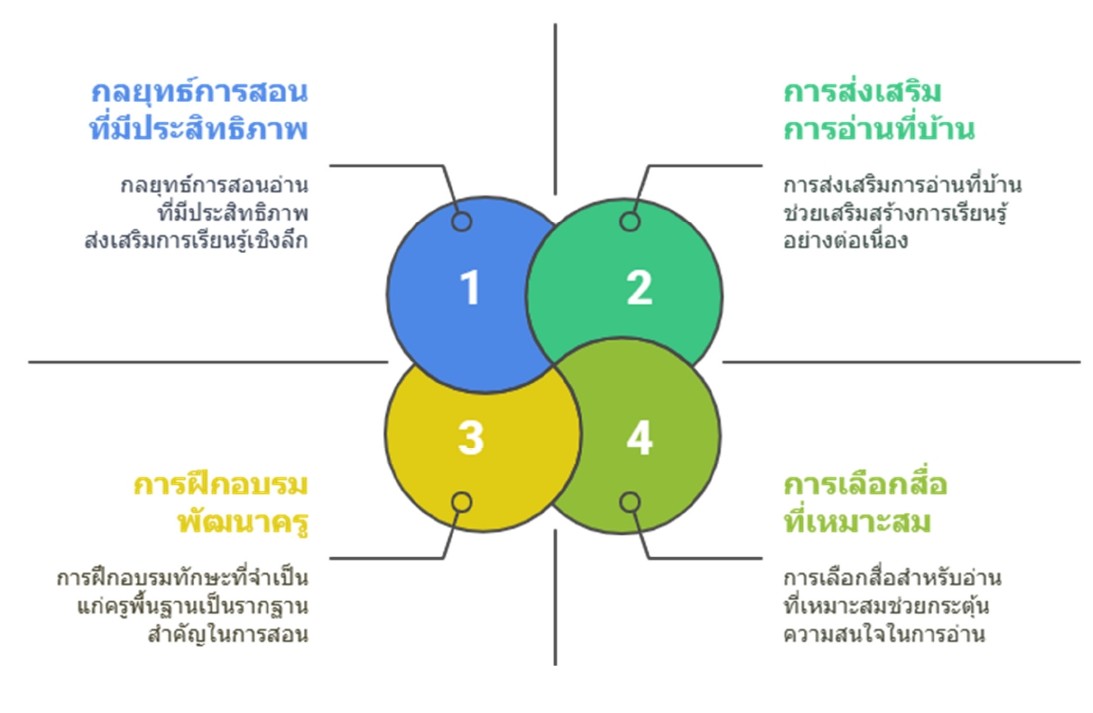Developing Reading Comprehension Achievement of Grade 4 Students Using SQ4R with E-Books
Main Article Content
Abstract
The purposes of this research were: 1) compare the reading comprehension achievement of Grade 4 students before and after learning with the SQ4R method and e-books, and 2) study student satisfaction with the learning approach. The research employed a quantitative one-group pretest-posttest design. The sample consisted of 29 students from class 4/2. The research instruments included lesson plans, e-books, a reading comprehension test, and a satisfaction questionnaire. Data analysis involved mean, standard deviation, and t-test.
The results revealed that:
1. The reading comprehension achievement of students significantly improved after the intervention at the .05 level.
2. The overall student satisfaction with the learning process was at the highest level ( = 2.83, S.D. = 0.38).
Article Details

This work is licensed under a Creative Commons Attribution-NonCommercial-NoDerivatives 4.0 International License.
เพื่อให้เป็นไปตามกฎหมายลิขสิทธิ์ ผู้นิพนธ์ทุกท่านต้องลงลายมือชื่อในแบบฟอร์มใบมอบลิขสิทธิ์บทความ ให้แก่วารสารฯ พร้อมกับบทความต้นฉบับที่ได้แก้ไขครั้งสุดท้าย นอกจากนี้ ผู้นิพนธ์ทุกท่านต้องยืนยันว่าบทความ ต้นฉบับที่ส่งมาตีพิมพ์นั้น ได้ส่งมาตีพิมพ์เฉพาะในวารสาร วิชาการธรรม ทรรศน์ เพียงแห่งเดียวเท่านั้น หากมีการใช้ ภาพหรือตารางของผู้นิพนธ์อื่นที่ปรากฏในสิ่งตีพิมพ์อื่นมาแล้ว ผู้นิพนธ์ต้องขออนุญาตเจ้าของลิขสิทธิ์ก่อน พร้อมทั้ง แสดงหนังสือที่ได้รับการยินยอมต่อบรรณาธิการ ก่อนที่บทความจะได้รับการตีพิมพ์References
กาญจนา แก้วมณี, นงนุช อนันตกาล และมยุรี สิทธิกัน. (2552). การพัฒนาหนังสืออิเล็กทรอนิกส์ส่งเสริมความสามารถด้านการอ่านจับใจความกลุ่มสาระการเรียนรู้ภาษาไทย ชุดท้องถิ่นเราชาวพิษณุโลก สำหรับนักเรียนชั้นประถมศึกษาปีที่ 6. (การค้นคว้าอิสระการศึกษามหาบัณฑิต). พิษณุโลก: มหาวิทยาลัยนเรศวร.
กุลวดี เผือกผุด. (2565). การพัฒนาการอ่านจับใจความของนักเรียนชั้นประถมศึกษาปีที่ 3 โดยใช้แบบฝึกเสริมทักษะการอ่านจับใจความ. เข้าถึงได้จาก http://www.pkk.ac.th/_files_school/77100918/data/77100918_1_20230707-053603.pdf
จินตนา ไชยฤกษ์, ประกอบ ใจมั่น และกรวรรณ สืบสม. (2562). การพัฒนาหนังสือนิทานอิเล็กทรอนิกส์เสริมทักษะการอ่านจับใจความภาษาอังกฤษ สำหรับนักเรียนชั้นประถมศึกษาปีที่ 6. วารสารนาคบุตรปริทรรศน์ มหาวิทยาลัยราชภัฏนครศรีธรรมราช, 11(1), 117-126. https://so04.tci-thaijo.org/index.php/nakboot/article/view/184270/129839
ฉัตรลัดดา เกิดสุภาพ. (2560). การพัฒนาผลสัมฤทธิ์ทางการอ่านจับใจความของนักเรียนชั้นประถมศึกษาปีที่ 5 โดยการจัดการเรียนรู้จากการสอนอ่านด้วยเทคนิค PQ4R. วารสาร มจร พุทธปัญญาปริทรรศน์, 3(2), 157-170. https://so03.tci-thaijo.org/index.php/jmbr/article/view/135864
ปาริชาติ นามน้าวแสง, ประสพสุข ฤทธิเดช และชัยวัฒน์ สุภัควรกุล. (2563). การพัฒนาความสามารถการอ่านจับใจความภาษาไทยของนักเรียนชั้นประถมศึกษาปีที่ 4 โดยใช้เทคนิค SQ4R. วารสารมหาวิทยาลัยราชภัฏมหาสารคาม, 14(2), 121-129. https://so05.tci-thaijo.org/index.php/rmuj/article/view/246635/167868
พิบูลย์ ตัญญบุตร และมีชัย เอี่ยมจินดา. (2559). การพัฒนาผลสัมฤทธิ์การอ่านจับใจความของนักเรียนชั้นประถมศึกษาปีที่ 5 ด้วยวิธีการจัดการเรียนรู้แบบ SQ4R ร่วมกับข้อมูลท้องถิ่นจังหวัดสุพรรณบุรี. วารสารศิลปากรศึกษาศาสตร์วิจัย, 8(1), 312-327. https://so05.tci-thaijo.org/index.php/suedureasearchjournal/article/view/38109/48593
วราวรรณ นันสถิตย์. (2560). การพัฒนาผลสัมฤทธิ์การอ่านจับใจความของนักเรียนชั้นประถมศึกษาปีที่ 5 ด้วยโมเดลการเรียนรู้แบบร่วมมือโดยใช้เทคนิค PQ4R. วารสารวิจัยและพัฒนาทางการศึกษา, 12(1), 121-136.
แววมยุรา เหมือนนิล. (2538). การอ่านจับใจความ. กรุงเทพฯ: สุวีริยาสาส์น.
ศิริพร ลิมตระการ. (2542). การอ่านภาษาไทย หน่วยที่ 1-7. (เอกสารการสอน). (พิมพ์ครั้งที่ 7). กรุงเทพฯ: มหาวิทยาลัยสุโขทัยธรรมาธิราช.
สวนิต ยมาภัย. (2546). การสื่อสารและการใช้ภาษา. กรุงเทพฯ: จุฬาลงกรณ์มหาวิทยาลัย.
สำนักงานคณะกรรมการการศึกษาขั้นพื้นฐาน. (2551). หลักสูตรแกนกลางการศึกษาขั้นพื้นฐาน พุทธศักราช 2551. เข้าถึงได้จาก http://academic.obec.go.th/images/document/1525235513_d_1.pdf
สุนันทา มั่นเศรษฐวิทย์. (2537). หลักและวิธีสอนอ่านภาษาไทย. กรุงเทพฯ: ไทยวัฒนาพานิช.
สุภาวดี พุทธศรี, พิทักษ์ นิลนพคุณ และชาตรี เกิดธรรม. (2559). การพัฒนาหนังสืออิเล็กทรอนิกส์เพื่อพัฒนาความสามารถในการอ่านจับใจความสําหรับนักเรียนชั้นประถมศึกษาปีที่ 4 โรงเรียนสาธิต มหาวิทยาลัยราชภัฏในเขตภูมิศาสตร์ภาคกลาง. ใน วิภาส ทองสุทธิ์ (บ.ก.), การประชุมวิชาการและเสนอผลงานวิจัยระดับชาติ ครั้งที่ 3 ก้าวสู่ทศวรรษที่ 2: บูรณาการงานวิจัย ใช้องค์ความรู้ สู่ความยั่งยืน, 17 มิถุนายน 2559 (หน้า 816-821). นครราชสีมา: วิทยาลัยนครราชสีมา.
สุรีย์ กลัดบุบผา. (2554). หนังสืออิเล็กทรอนิกส์คืออะไร. เข้าถึงได้จาก https://cms.dru.ac.th/jspui/bitstream/123456789/903/11/Bib.pdf
Best, J. W. (1977). Research in Education. New Jersey: Prentice hall Inc.
Escar, E. (2023). The impact of reading comprehension on learning. Retrieved from https://online.ewu.edu/degrees/education/med/reading-literacy/reading-comprehension-on-learning/
Herlina. (2016). Improve Reading Ability Understanding English Through SQ4R Method. Retrieved from https://www.researchgate.net/publication/342083258
Jackson, P. (2004). The future of e-books: A study of the impact of e-books on the publishing industry. Journal of Electronic Publishing, 7(2). https://doi.org/10.3998/3336451.0007.202
Khusniah, N. L. (2017). Improving english reading comprehension ability through survey, questions, read, record, recite, review strategy (SQ4R). English Language Teaching, 10(12), 202-211. https://eric.ed.gov/?id=EJ1161897
Kitaboo. (2024). Importance of eBooks in Online Education in 2024. Retrieved from https://kitaboo.com/importance-of-ebooks-in-education/
Robinson, F. P. (1961). Effective Study. New York: Harper & Row.
Simbolon, N., Marbun, I., & Simanjuntak, E. B. (2020). Evaluating Reading Comprehension Ability Through the SQ4R Model. Utopía y Praxis Latinoamericana, 25(6), 511-523, https://doi.org/10.5281/zenodo.3987673
Slotte, V., & Lonka, K. (1999). Review and process effects of spontaneous note-taking on text comprehension. Contemporary Educational Psychology, 24(1), 1-20. https://doi.org/10.1006/ceps.1998.0980
Thorndike, E. L. (1913). Educational psychology. New York: Teachers College, Columbia University.

